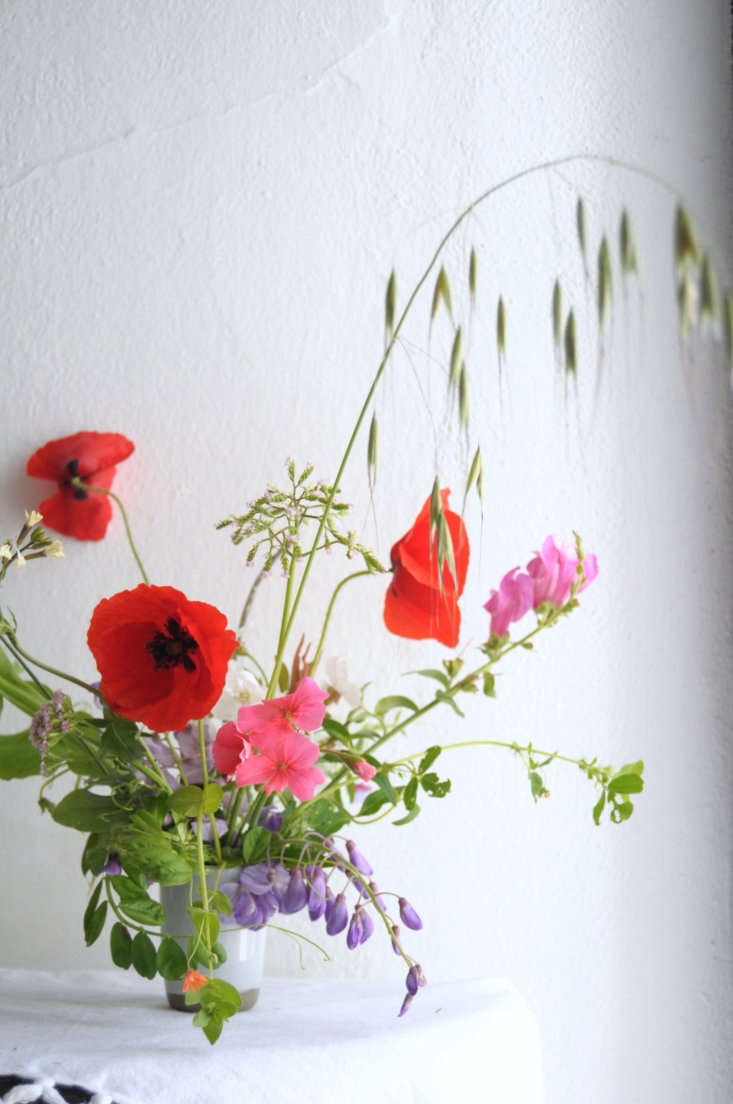The wild red poppies of Europe (Papaver rhoeas) have symbolized remembrance for soldiers since World War I when poet John McCrae wrote In Flanders Field, describing a landscape where “the poppies blow, Between the crosses, row on row, That mark our place; and in the sky, The larks, still bravely singing, fly, Scarce heard amid the guns below.”
In the fields of Italy, France, Spain, and Portugal, the corn poppy is also a symbol of springtime and rebirth. Here in Portugal, we have quite a few varieties of wild poppy (with the corn poppy being the most common). I hear a lot from home gardeners and florists who are afraid to cut them because of their short vase life. But as with violets, poppies’ fleeting nature does not deter me from bringing them indoors.
The fragility and temporary blossoms intrigue me, making their presence all the more special. Picked wild, they will be even more fragile then commercially grown poppies. But if handled properly, you will enjoy poppies indoors for up to five days. Follow these steps and you will be surprised at the vase life of this fragile spring flower.
Photography and styling by Chelsea Fuss.
1. Harvest and condition the poppies.

See the poppy above? It is halfway open, you cannot yet see the black center. Pick the poppies when they are halfway open, or in a loose bud, nearly open. If the buds aren’t too tight, they should open, but this is inconsistent. So I usually pick a mix.
2. Keep cut flowers in water.

3. Seal the stems.

Poppies have a sap, and this seals off the end so that they can retain moisture. Keep them in the bucket in a cool, dark place—away from bright sun or drafts. Poppies will be very susceptible to dramatic changes in temperature or strong breezes.
4. Let the poppies rest.

Next, cut the stems to the desired length and remove extra leaves (this will help them last longer) and dip them into a just-boiled pot of water to seal the stems again. You’ll notice after a night in a deep bucket of water the poppies will have recovered from the trauma of being harvested. The flowers open with light and close with darkness, so watch them change with the light and time of day.
5. Arrange the poppies.

Part of the appeal of poppies is their curly stems, tissue paper petals, and nodding necks. Don’t place them all face-forward. Place them at different angles so that you can appreciate the stems, the spots of black on the underside of the petals, and their papery petals.
Here, I’ve created a minimal wildflower arrangement. Poppies are dramatic on their own, but I like softening them a bit with grasses and meadow flowers, just as they would grow in the wild. I also like to play with their saturated color by mixing them with greens, corals, purples, and hot pinks. Just a few other stems of these saturated colors creates an almost neon arrangement.

For a simple, but artful arrangement, place just a few stems in a tall vase with a narrow neck, leaving the stems supported and featuring the dramatic blossoms like art to bring the corner of a room to life. Here, I’ve added an orange branch for a contrasting color. Be sure to leave the stems at different heights to fully appreciate each flower.



For more growing and care tips, see Poppies: A Field Guide in our curated design guides to our favorite Annuals, including Cosmos, Nasturtium, and Sweet Pea. Don’t miss the rest of our Rethinking Flowers series:
- African Violets: Rethinking ‘America’s Favorite House Plant’ for Modern Times
- Kalanchoe: Rethinking a Kitschy Houseplant
- Carnations: Rethinking a Supermarket Flower












Have a Question or Comment About This Post?
Join the conversation (0)